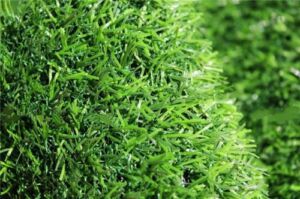
Generally, the seepage drainage method is adopted. The underground seepage system is closely related to the site structure and often adopts the form of blind ditch. The drainage slope of the artificial turf foundation outdoor ground should be controlled within the range of 0.3% to 0.8%. The slope of the artificial turf field (without water seepage function) should not be greater than 0.8%, and the slope (with water seepage function) should be 0.3%. The drainage ditch of the outdoor venue shall not be less than 400mm.
1. The water drop and torrent trough must be built with masonry structures. The height of the water drop step can be determined according to terrain, geology and other conditions. The height of each step of multi-step steps can be different, and the ratio of its height to length should be consistent with the original ground slope. Accordingly, the step height should generally not be 0.5~0.6m, but usually 0.3~0.4m.
2. The falling water can be poured with mortar rubble or cement concrete. The thickness of the trench wall and the side wall of the stilling tank: 0.25~0.4m for mortar rubble and 0.2m for concrete. The height should be at least 0.2m higher than the calculated water level. The bottom thickness is 0.25~0.4m, and a water isolation wall is installed at the outlet.
3. Falling water is generally equipped with a stilling sill. When setting up, the top width of the sill is not less than 0.4m, and a drain hole with a size of 5cm*5cm~10cm*10cm is provided to remove the accumulated water in the stilling pool when the water is interrupted. .
4. The water tank is generally built in a rectangular shape, but the water drop height is not large and the longitudinal slope of the bottom of the tank is gentle. It can also adopt a trapezoidal section. The trapezoidal water tank body should be 0.5~1.0m in front of the steps and 1.0~1.5m behind the steps. Reinforcement within the scope.
5. The longitudinal slope of the rapid trough should generally not exceed 1:1.5. It can be constructed with mortar pieces (blocks) or concrete.
6. In order to prevent sliding, an anti-skid platform can be built on the back of the slope rapids trough to prevent sliding.
7. The bottom of the inlet and outlet tanks should be paved with rubble and jointed with cement slurry. The length is generally not less than 10m. In individual cases, anti-scouring paving with a thickness of 0.2~0.5m and a length of 2.5m should be laid downstream.
8. When the torrent tank is very long, it should be built in sections, and the length of each section should not exceed 10m. The joints should be filled with waterproof materials to make them dense and without gaps.
9. The rapid flow tank should be built with a rough surface or embedded with solid stones of about 10cm*10cm to dissipate energy and reduce the flow rate.
10. For torrent chutes on road cutting slopes with large water catchment areas, consideration should be given to enlarging and deepening the size of the torrent chutes, and installing energy dissipation facilities at the bottom before introducing them into the roadbed drainage system.

